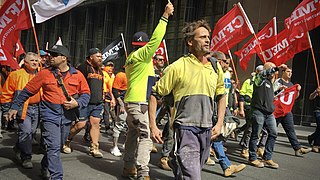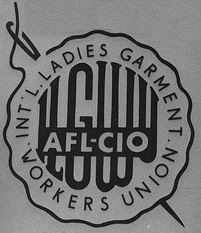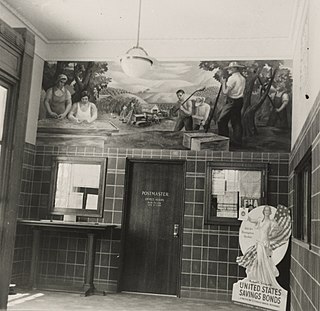
Strike action, also called labor strike, labour strike, or simply strike, is a work stoppage caused by the mass refusal of employees to work. A strike usually takes place in response to employee grievances. Strikes became common during the Industrial Revolution, when mass labor became important in factories and mines. As striking became a more common practice, governments were often pushed to act. When government intervention occurred, it was rarely neutral or amicable. Early strikes were often deemed unlawful conspiracies or anti-competitive cartel action and many were subject to massive legal repression by state police, federal military power, and federal courts. Many Western nations legalized striking under certain conditions in the late 19th and early 20th centuries.

The United Farm Workers of America, or more commonly just United Farm Workers (UFW), is a labor union for farmworkers in the United States. It originated from the merger of two workers' rights organizations, the Agricultural Workers Organizing Committee (AWOC) led by organizer Larry Itliong, and the National Farm Workers Association (NFWA) led by César Chávez and Dolores Huerta. They became allied and transformed from workers' rights organizations into a union as a result of a series of strikes in 1965, when the mostly Filipino farmworkers of the AWOC in Delano, California, initiated a grape strike, and the NFWA went on strike in support. As a result of the commonality in goals and methods, the NFWA and the AWOC formed the United Farm Workers Organizing Committee on August 22, 1966. This organization was accepted into the AFL–CIO in 1972 and changed its name to the United Farm Workers Union.
The Oxnard strike of 1903 was a labor rights dispute in the southern California coastal city of Oxnard between local landowners and the majority Japanese and Mexican labor force.

The 1934 West Coast Waterfront Strike lasted 83 days, and began on May 9, 1934 when longshoremen in every US West Coast port walked out. Organized by the International Longshore and Warehouse Union (ILWU), the strike peaked with the death of two workers on "Bloody Thursday" and the San Francisco General Strike which stopped all work in the major port city for four days and led ultimately to the settlement of the West Coast Longshoremen's Strike.

The International Ladies' Garment Workers' Union (ILGWU), whose members were employed in the women's clothing industry, was once one of the largest labor unions in the United States, one of the first U.S. unions to have a primarily female membership, and a key player in the labor history of the 1920s and 1930s. The union, generally referred to as the "ILGWU" or the "ILG", merged with the Amalgamated Clothing and Textile Workers Union in the 1990s to form the Union of Needletrades, Industrial and Textile Employees (UNITE). UNITE merged with the Hotel Employees and Restaurant Employees Union (HERE) in 2004 to create a new union known as UNITE HERE. The two unions that formed UNITE in 1995 represented 250,000 workers between them, down from the ILGWU's peak membership of 450,000 in 1969.
Justice for Janitors (JfJ) is a social movement organization that fights for the rights of janitors across the US and Canada. It was started on June 15, 1990, in response to the low wages and minimal health-care coverage that janitors received. Justice for Janitors includes more than 225,000 janitors in at least 29 cities in the United States and at least four cities in Canada. Members fight for better wages, better conditions, improved healthcare, and full-time opportunities.

The Delano grape strike was a labor strike organized by the Agricultural Workers Organizing Committee (AWOC), a predominantly Filipino and AFL-CIO-sponsored labor organization, against table grape growers in Delano, California to fight against the exploitation of farm workers. The strike began on September 8, 1965, and one week later, the predominantly Mexican National Farmworkers Association (NFWA) joined the cause. In August 1966, the AWOC and the NFWA merged to create the United Farm Workers (UFW) Organizing Committee.

The California agricultural strikes of 1933 were a series of strikes by mostly Mexican and Filipino agricultural workers throughout the San Joaquin Valley. More than 47,500 workers were involved in the wave of approximately 30 strikes from 1931-1941. Twenty-four of the strikes, involving 37,500 union members, were led by the Cannery and Agricultural Workers' Industrial Union (CAWIU). The strikes are grouped together because most of them were organized by the CAWIU. Strike actions began in August among cherry, grape, peach, pear, sugar beet, and tomato workers, and culminated in a number of strikes against cotton growers in the San Joaquin Valley in October. The cotton strikes involved the largest number of workers. Sources vary as to numbers involved in the cotton strikes, with some sources claiming 18,000 workers and others just 12,000 workers, 80% of whom were Mexican.
The California Immigrant Workers Association(CIWA) was an AFL–CIO associate membership organization from 1989–1994. Initiated by AFL–CIO regional director David Sicker with support from labor unions in California, CIWA helped undocumented immigrants to regularized their immigration status under the Immigration Reform and Control Act of 1986, and supported organizing campaigns among immigrant workers into the labor movement.

The Vacaville tree pruners' strike of 1932 was a two-month strike beginning on November 14 by the CAWIU in Vacaville, California, United States. The strikers were protesting a cut in tree pruning wages from $1.40 for an eight-hour workday to $1.25 for a nine-hour workday. The strike was characterized by multiple violent incidents including a break-in at the Vacaville jail that resulted in the kidnapping and abuse of six arrested strike leaders. The strikers were ultimately unsuccessful in demanding higher wages and fewer hours and the CAWIU voted to end the strike on January 20, 1933.

The Little Steel strike was a 1937 labor strike by the Congress of Industrial Organizations (CIO) and its branch the Steel Workers Organizing Committee (SWOC), against a number of smaller steel producing companies, principally Republic Steel, Inland Steel, and Youngstown Sheet and Tube Company. The strike affected a total of thirty different mills belonging to the three companies, which employed 80,000 workers. The strike, which was one of the most violent labor disputes of the 1930s, ended without the strikers achieving their principal goal, recognition by the companies of the union as the bargaining agent for the workers.
The Cantaloupe strike of 1928 was labor movement of cantaloupe pickers in Imperial Valley, California. On May 7, 1928 cantaloupe pickers walked off of the job and the strike lasted to May 10 of the same year. The strikers had hardly any outside support and many were effectively imprisoned by local police for gathering together in any public space during the strike. The strikers were mostly Mexican immigrants or of Mexican descent because they comprised the vast majority of produce laborers in California, about 3,500 to 4,000 Mexicans worked as cantaloupe pickers. While the strike was short-lived and seemingly unorganized, it stands as a victory for the workers.
The Hawaiian sugar strike of 1946 was one of the most expensive strikes in history. This strike involved almost all of the plantations in Hawaii, creating a cost of over $15 million in crop and production. This strike would become one of the leading causes for social change throughout the territory.
The Santa Clara cannery strike occurred during the summer of 1931. Workers spontaneously walked out of canneries in order to protest a 20% cut in wages. These workers were met with violence from local authorities, and strikebreakers were brought in to replace the workers. While this strike was unsuccessful, it marked the beginning of organizing cannery workers.
The Los Angeles Garment Workers strike of 1933 is considered to be one of the most influential strikes in Los Angeles after the passing of the New Deal. The strike is known for being one of the first strikes where Mexican immigrant workers played a prominent role. The garment workers strike occurred in the fall of 1933 in the downtown Garment District in Los Angeles, California. Leaders of the strike, including Rose Pesotta and other members of the International Ladies Garment Workers Union (ILGWU), organized the strike to be culturally orientated in order to include Mexican immigrant workers to fight for union recognition in the garment industry.
The Pacific Electric Railway strike of 1903 was an industrial dispute between Mexican tracklayers and their employers on the construction of the Main Street streetcar line in Los Angeles. The dispute began on April 24 when the workers, known as the "Traqueros", demanded higher wages to match those of the European immigrants working on the same project, and stopped work. It ended on April 29 when the union organising the strike failed to persuade workers on rest of the streetcar system to join the strike, and the labourers returned to work.

The Los Angeles streetcar strike of 1919 was the most violent revolt against the open-shop policies of the Pacific Electric Railway Company in Los Angeles. Labor organizers had fought for over a decade to increase wages, decrease work hours, and legalize unions for streetcar workers of the Los Angeles basin. After having been denied unionization rights and changes in work policies by the National War Labor Board, streetcar workers broke out in massive protest before being subdued by local armed police force.

In 1933 there was a cherry strike in Santa Clara, California. The main overview of the events in Santa Clara was an agricultural strike by cherry pickers against the growers or employers. As the events of the labor strike unfolded, the significance of the strike grew beyond that of the workers themselves into a broader scope within America.
The Farah strike (1972–1974) was a labor strike by the employees of Farah Manufacturing Company, a clothing company in El Paso, Texas and New Mexico. The strike started at the Farah plant in San Antonio in 1972 when the Hispanic women, called Chicanas, led by Sylvia M. Trevino, at the company demanded a labour union formation to fight for better working conditions. The two-year long strike included 4,000 individuals, of which the majority were women.
The 1985–1987 Watsonville Cannery strike was a labor strike that involved over 1,000 workers at two food processing facilities in Watsonville, California, United States. The facilities were owned by Watsonville Canning and Richard A. Shaw Inc., two of the largest frozen food processors in the United States, while the workers were all union members of the International Brotherhood of Teamsters (IBT) Local 912. The strike began on September 9, 1985, and completely ended about 18 months later, on March 11, 1987.










